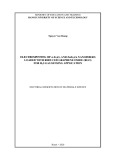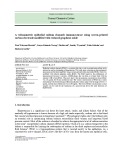
ISSN: 2615-9740
JOURNAL OF TECHNICAL EDUCATION SCIENCE
Ho Chi Minh City University of Technology and Education
Website: https://jte.edu.vn
Email: jte@hcmute.edu.vn
JTE, Volume 19, Special Issue 05, 2024
67
Fabrication of a Superhydrophobic RGO Coated-Polyurethan Sponge for
Removing Oil, Organic Solvent, and Gasoline from Water
Thi Phuong Nhung Nguyen*, Trung Tien Phan , Quoc Viet Dang , Huu Thang Vuong
PetroVietnam University, Ba Ria-Vung Tau Province, Viet Nam
*Corresponding author. Email: nhungntp@pvu.edu.vn
ARTICLE INFO
ABSTRACT
Received:
28/04/2024
In recent years, the issue of oil and organic spillage caused by human
population growth has become increasingly urgent, not only in Vietnam
but also worldwide. Researchers are showing great interest in the research
and development of materials capable of selectively absorbing oils and
organic solvents while repelling water. In this project, an oil-absorbing
material was developed using reduced graphene oxide particles
incorporated into a polyurethane (PU) foam base. Utilizing PU sponge as
the base material enhances the oil absorption capacity of the material.
Graphene oxide was initially synthesized using the Hummers method and
then reduced with ascorbic acid to form reduced graphene oxide (RGO).
RGO was applied to the sponge with varying loading amounts, ranging
from 0 to 254%. Subsequently, the porous material was coated with high-
density polyethylene (HDPE) to assess its hydrophobicity and its ability to
adsorb oil and organic solvents. The results indicate that the oil and organic
solvent absorption capacity of RGO and HDPE coating materials is highest
at RGO loading percentages exceeding 64%, yielding absorption rates
ranging from 35 to 63 times the weight of the material. Additionally, the
contact angle of RGO and HDPE coating materials is approximately 150°,
demonstrating the high hydrophobicity of the material.
Revised:
20/05/2024
Accepted:
04/09/2024
Published:
28/12/2024
KEYWORDS
Oil/water separation;
Superhydrophobic sponge;
Reduced graphene;
Superoleophilic;
HDPE.
Doi: https://doi.org/10.54644/jte.2024.1573
Copyright © JTE. This is an open access article distributed under the terms and conditions of the Creative Commons Attribution-NonCommercial 4.0
International License which permits unrestricted use, distribution, and reproduction in any medium for non-commercial purpose, provided the original work is
properly cited.
1. Introduction
The development of superhydrophobic materials has been a prominent focus in both academic studies
and practical industries. A superhydrophobic material or surface is one that displays a contact angle
exceeding 150°[1]. Drawing inspiration from the natural superhydrophobic properties observed in lotus
leaves, researchers have recognized that crafting artificial superhydrophobic surfaces necessitates a
combination of surface roughness or structure alongside careful management of surface energy [2], [3],
[4]. Over the past decade, these surfaces have found diverse applications across fields such as anti-
corrosion coatings [5], anti-wax treatments [6], self-cleaning mechanisms [7], anti-fog solutions [8],
anti-adhesion technologies [9], and water/oil separation [10]. Various methods have been employed to
achieve artificial superhydrophobic surfaces, with most techniques relying on two primary principles:
creating structured surfaces to amplify surface area and chemically modifying the surface to lower its
energy [5] - [10].
On the other hand, the increasing demand for fossil fuels has led to the expansion of fossil fuel
infrastructures, resulting in more oil spills and leaks of pollutants. Consequently, the removal of oil,
organic solvents, and gasoline from water has garnered significant attention over the years. Various
techniques have been employed to separate oil from water, including physical methods such as
skimmers, booms, meshes, barriers, and absorbents, chemical methods using dispersants and solidifiers,
and biological methods.
Among these environmental remediation strategies for oil spills, mechanical remediation using
sorbent materials is considered one of the most efficient [11]. However, conventional absorbents like











